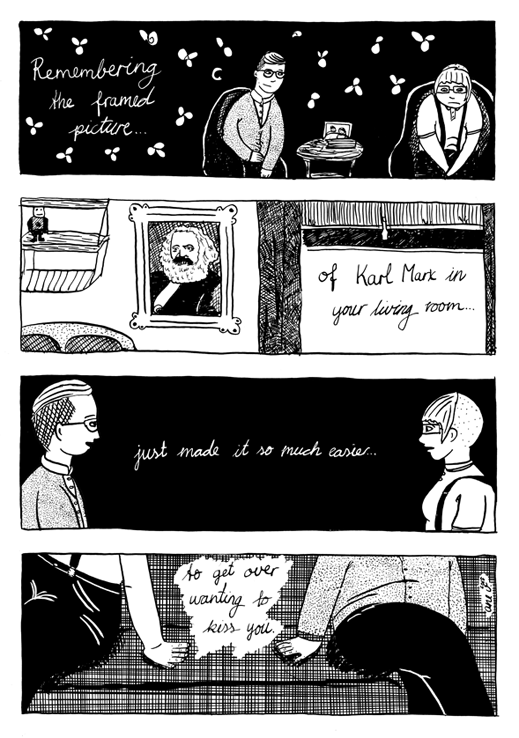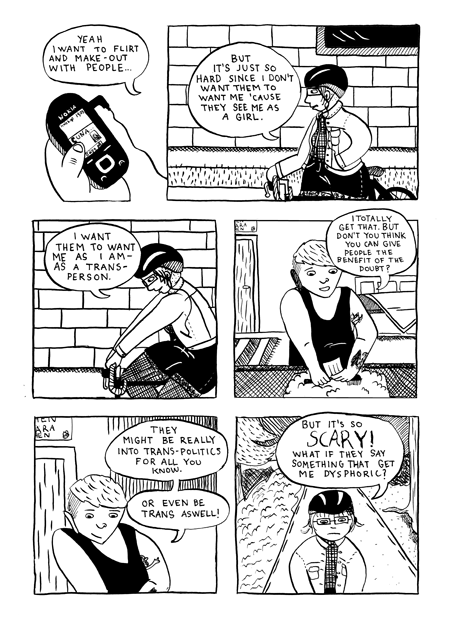30 Mar 2016
Interview
A Chat With Ane V.

Ane V. is working at Studio 3 of the Cable Factory between the 6th and 20th of March. I popped by for a cup of tea, some origami folding, and a lovely chat.
Talking to Ane is such a pleasure. They describe themselves as an angry activist, but come across as bubbly, very chatty, and accommodating. We end up talking more about vegan food and chocolate-dipped-apples than art, even though we talk about art a lot, too.
TA: When did you first decide that you wanted to create your comics as a career?
AV: I have never been too interested in making money from my comics. Working with art seems like such a privilege to me. I grew up working class, not ever really having much money. For nine years I have worked at home services for one month a year, saving my pay check and getting by on that for the rest of the year. Then I went to comics school, so I haven’t been working on comics for that long full-time. I have previously been involved in veganism, animal liberation, activism, and the punk scene of my home town. I also worked for some time with the Dotterbolaget collective.
As a teenager, I started making punk zines that I used to trade with people at shows. When I was 18, I traded one of my punk zines with someone’s comic zine. It was a turning point for me. That’s when I first realised that important stories can be told through comics. I made my first comic zine in 2009. It was about living in Umeå. Other early topics included my cats interrupting my drawing and long distance relationships. These days I work a lot. I have made ten zines in the last year.
But comics as a career? I’m not sure they still are. Comics take a lot of time to make. It is impossible to work enough to get rich. Zines are very cheap, yet people don’t even look at them. They want the posters and badges and don’t appreciate the work that goes into the comics themselves. Also applying for grants often makes me feel stupid. These upper class people thinking I can’t express myself all that well. In the end, I don’t even want their money. Financial insecurity is damaging to people’s health, however, and very stressful. This is why I’m not interested in making a lot of money from comics. I work in art because I have stories to tell, but I make a living elsewhere.
TA: What has had the biggest influence on you outside the comics industry?
AV: I am a small town punk romantic. I get inspired by people living in the North who seem to be cut away from everything, yet they are very involved in the local hardcore scene. These people make cool stuff happen in small towns. This scene that I grew up in is still present in all my comics. The comics take place in this hardcore universe. Also, I read a lot, maybe 150 books a year. I try to read all comics that come out in Sweden. I also read a lot of science fiction and manga. I am very inspired by manga storytelling and generally storytelling that is slow, with lots of panels and lots of landscapes. I am inspired by nature and I use it as a metaphor for peace, quiet, and being safe. I’m also inspired by films. My comic storytelling very much resembles a film script or storyboard.
TA: What does your typical work routine consist of?
AV: I work best in the morning. I try to set my alarm early in the morning and work strictly for a few hours. After my lunch break I usually work for a few more. I have ADHD, so I need to work to a routine. If it looks like I can’t focus, I will do something that requires less emotional attachment, like inking.
TA: Are there any special tools or methods you use to create your comics?
AV: Long stories come naturally to me, so I try to challenge myself by making very small zines. Small size forces me to write short. I mostly use ink and fountain pen and also those green pens that you don’t have to erase. My originals are also the right size and they look finished. I do not like to fix things on a computer. I’m lazy and I don’t want to work more than I need to. No, let’s call that effective! I’m not lazy, I’m effective.
The majority of my time and effort goes to thinking and planning. I write a script and process it in my head before drawing. The actual drawing part happens very quickly. Drawing has to be fast, so it is an emotional response to the script but not sloppy. I also process the script in chronological order from start to finish because I need to be back where I was at the time, emotionally.
TA: What is your work about and why is it so important to you?
AV: The core message of my work is the lack of representation of non-binary transgender people in the media. My personal experiences as a trans person, as well as the political message of the treatment of trans people. My current project has changed from being a short zine about my flatmate who ended their own life, to a 250-page book about my personal experience of being trans. It is about my grief over the flatmate that I lost, and also about the fear that it could have been my fate as well. I have been suicidal, too, you know. It is a common fate for transgender people. It has taken me a lot of effort not to fall into that mindset again. These days I try to actively make a difference, being the trans voice that the comics industry has been lacking. Friends, activism, and resistance keep me alive. Also, whenever I get anxious, I fold origami envelopes.
TA: Will you show me? I get stressed out a lot, too.
And they do. We fold origami and drink green tea, and it all seems far from angry, or worried, or anxious.

Text by Tessa Aarniosuo.
Images courtesy of the artist.
